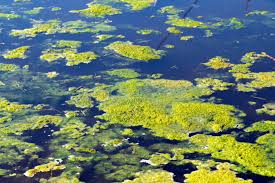In recent years, news stories about cyanobacteria and algae blooms closing beaches in B.C. and across Canada have raised concern among lake visitors. While Lake Windermere hasn’t faced major algae bloom issues, people often wonder if any algae is bad. And the truth is, they’re not. Algae, including cyanobacteria, are always present in lakes, and in the right amounts, they’re not a problem at all. In fact, they’re essential.
In Lake Windermere, algae appears naturally in various forms. A common appearance is through thin green film or slippery coating, known as periphyton/algal mats, occurring on rocks near the shore, which is often noticed when someone wades in the area or picks the rock up. In the summer months, a light green tint in the water indicates the presence of phytoplankton, a normal and seasonal tendency to witness in the lake. Lastly, Lake Windermere occasionally exhibits algae through small floating clumps of algae or plant-like material near the surface or washed up along the shoreline. These can look like tiny green threads or fuzz or can appear hair-like in the event the algae is filamentous. These various species of algae perform a vital role in oxygen production and nutrient cycling. By relying on photosynthesis to create food and creating oxygen as a byproduct of the process, algae perform a crucial role in returning oxygen to the lake for the use of other living organisms. Additionally, algae absorb nutrients such as nitrogen and phosphorus from the water in order to grow. By doing so, they help remove excess nutrients from the lake and fixate them into use for themselves as well as for the animals that eat the algae, allowing these nutrients to be accessible to the food chain. Once the algae dies, the nutrients it carries is decomposed into the sediment to allow the nutrients to cycle again. This is also the reason why algae blooms are linked to excess phosphorus and nitrogen presence in water systems. Lastly, algae provide a critical base to the aquatic food web as primary producers. They are the main food supply for primary consumers such as small fish that live in the lake.
So, where does the problem with algae growth occur?
The problem with algae growth arises when the lake temperatures increase which allows the metabolism of the algae to also grow, creating a rapid reproduction rate and out of control growth (eutrophication). Another factor to rapid algae growth is when the nitrogen and phosphorus levels in a water body are excess. This causes the algae to also reproduce more rapidly as their food source is abundant which creates eutrophication as well. The increased presence of algae feeds into an increased number of algae dying and decomposing, depleting the oxygen in the water for use for decomposition. Since most of the oxygen is being used for decomposition, very little oxygen is left for other living organisms of the lake. As a result, an algae bloom occurs and the issues highlighted in the news such as closed beaches and toxic cyanobacteria growth come to life. In Lake Winderemere, recreational pressures, shoreline development, as well as nutrient release from industries such as golfing, farming, forestry, and mining all put pressure on the lake for algae growth. Warmer and drier summers further increase the risk of algae blooms in this lake and if prevention and caution is not enforced, Lake Winderemere remains highly susceptible to an algae bloom in the near future.
Therefore, it is clear algae performs a vital role in maintaining a healthy aquatic ecosystem and their presence does not indicate unhealthy water systems. However, when rapid algae growth occurs and eutrophication is evident, then issues arise. It is vital to enforce best management practices and preventative measures on time to preserve the natural ecological balance of our lake so that its use can be there for all for several generations to come.
References
APEC WATER. (2025, April 21). Algae on water supplies. APEC WATER. https://www.apecwater.com/blogs/water-quality/j-3-08-algae-beneficial-effects-on-water-supplies?srsltid=AfmBOorMm_LigFa3cJAmDzxOiOfymMqZ5Rom9sYFzo8xpnTloqDRhEOJ
INDIANA DEPARTMENT OF ENVIRONMENTAL MANAGEMENT. (n.d.). Fact sheet algae in aquatic ecosystems . Office of Water Quality. https://www.in.gov/idem/files/factsheet_owq_sw_algae_aquatic.pdf
Lake algae: – the good, the bad, and the ugly. Minnesota Environmental Partnership. (n.d.). https://www.anokacountymn.gov/DocumentCenter/View/749/Lake-Algae-Lake-Algae-the-Good-the-Bad-and-the-Ugly-PDF
Province of British Columbia. (2022, June 13). What causes an algae bloom?. Ministry of Environment. https://www2.gov.bc.ca/gov/content/environment/air-land-water/water/water-quality/algae-watch/what-are-algae/causes-of-an-algae-bloom
Thelman, L. (n.d.). Algae – good, bad, or ugly?. Ausable River Association. https://www.ausableriver.org/blog/algae-good-bad-or-ugly

